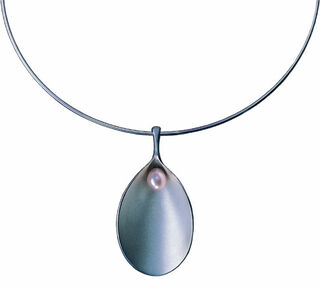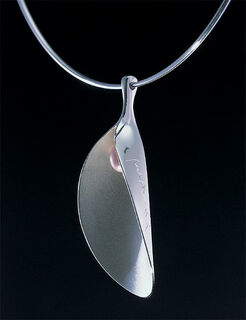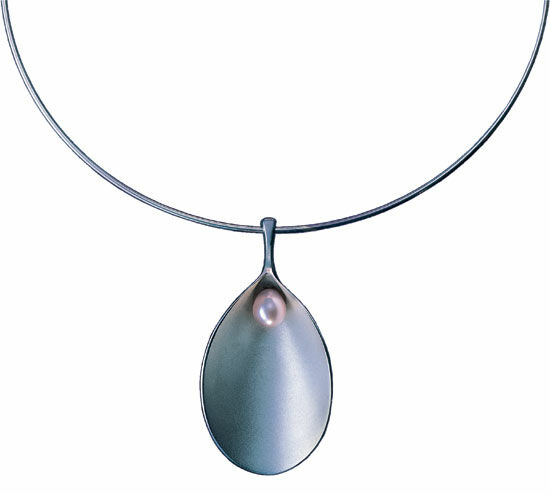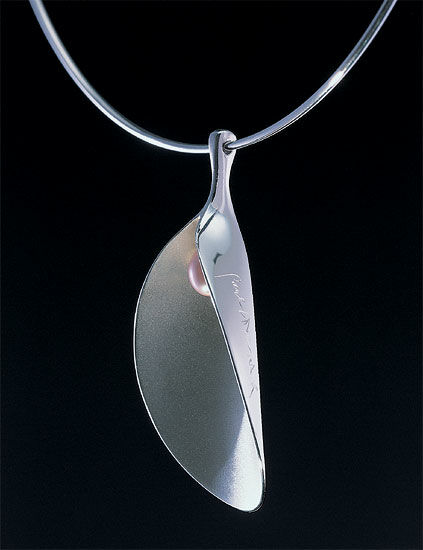"Venus Necklace" with cultured pearl
"Venus Necklace" with cultured pearl
Quick info
925 sterling silver + cultured pearl | numbered | signed | silver hallmark | pendant 5 cm | necklace Ø 13.5 cm | signed certificate
Detailed description
"Venus Necklace" with cultured pearl
Venus is the goddess of love and beauty. She is called the foam-born because it is said that she rose from whitecaps after her birth on the island of Cyprus. Renaissance painters associated the birth of the goddess of love with the shell, such as Sandro Botticelli for his famous painting "The Birth of Venus". There is no doubt that Botticelli's depiction inspired Paul Wunderlich. Wunderlich, with the imagination of an artist and the precision of a mathematician, developed an ideal shape that does not deny its origins in the representational and yet transcends reality.
The "Venus necklace" by Paul Wunderlich consists of a slightly curved oval that holds a shimmering cultured pearl inside a matt concave. The shell-shaped necklace has a shiny polished finish on the outside, creating a charming contrast between the two surfaces on the inside and the outside. The necklace is made of solid sterling silver. On the back, it is stamped with the artist's signature, numbering and silver hallmark.
Necklace made of solid 925 sterling silver with a Japanese cultured pearl, numbered and signed, and with the official silver hallmark. The height of the pendant is 5 cm. The diameter of the hoop is 13.5 cm. Each copy comes with a certificate signed by the artist.
Customer reviews
ist bei der Beschenkten sehr gut angekommen
Schnell und unkomliziert zu bestellen und ebenso zu liefern gegen Rechnung
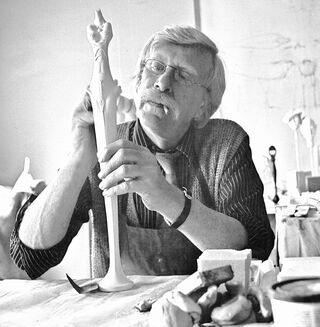
About Paul Wunderlich
1927-2010
Like no other artist of our time, Paul Wunderlich was one of the most influential style-forming artists of the modern age. Only in 1960, the Hamburg prosecutor seized his works for "indecent". Three years later, the relativley young Paul Wunderlich was hired as a professor at the University of Fine Arts. Numerous awards such as the Edwin Scharff Prize honours at the biennial arts exhibition in Ireland, Taiwan and Bulgaria made Wunderlich internationally famous. He was the only German artist to be admitted to the Paris "Académie des Beaux-Arts". Paul Wunderlich lived and worked both in Hamburg and France until his death in June 2010.
Born in 1927 in Eberswalde near Berlin, the painter and sculptor learned to draw at the Palace School of Art in the Orangery of Eutin Castle. Immediately after World War II, he visited the Hamburg Academy of Fine Arts to study graphic arts. After completing his studies, he remained there working as a drawing teacher and in 1963 became a professor.
In the early 1950s, he met Emil Nolde and Oskar Kokoschka. Under their guidance he printed reproductions of their works. He developed a very idiosyncratic style in which manneristic and surrealistic, as well as elements of Art Nouveau and Art Deco, meet. He initially drew his themes inspired by German history, for example the cycle of lithographs "20 July 1944". Later, erotic and sexual motifs became more significant which he treated with delicacy and also a hint of morbidity. In 1960, one such cycle of lithographs was seized by the Hamburg prosecutor for indecent depictions.
In the 1960s he began to work based on photographs by Karin Székessy. After he resigned from his professorship in 1968, he made several study trips to New York and Switzerland. From then on, he also worked on sculpturally aestheticised everyday objects that were parallel with the subtly crafted imagery of his lithographs.
"His works are recognised, appreciated and also bought by a broad public all over the world," writes Paul Wunderlich's biographer Jens Christian Jensen. "Art connoisseurs agree: Paul Wunderlich is the leading master of fantastic realism and one of the very few style-forming artists of our time."
"Out of all the truisms that are spread about his life's work, only one fact is for sure: the realisation that Paul Wunderlich became the unsurpassed master of lithography after Picasso." (Prof. Heinz Spielmann)
"If one searches for the greatest master in the art of lithography in all its possibilities, there is no doubt that Paul Wunderlich deserves all credits." (Carl Vogel)

